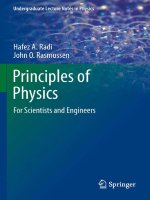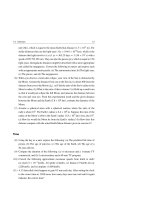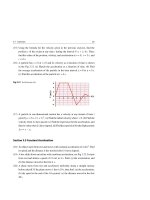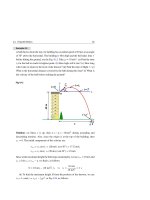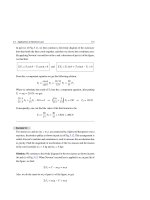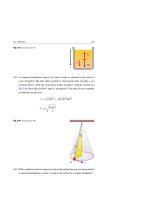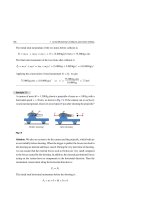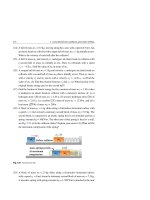Hafez a radi, john o rasmussen auth principles of physics for scientists and engineers 05
Bạn đang xem bản rút gọn của tài liệu. Xem và tải ngay bản đầy đủ của tài liệu tại đây (766.25 KB, 30 trang )
4.2 Projectile Motion
85
Example 4.4
A ball thrown from the top of a building has an initial speed of 20 m/s at an angle
of 30◦ above the horizontal. The building is 40 m high and the ball takes time t
before hitting the ground, see the Fig. 4.12. Take g = 10 m/s2 . (a) Find the time
t1 for the ball to reach its highest point. (b) How high will it rise? (c) How long
will it take to return to the level of the thrower? (d) Find the time of flight t . (e)
What is the horizontal distance covered by the ball during this time? (f) What is
the velocity of the ball before striking the ground?
Fig. 4.12
y
t = t1
t=0
t=T
x
40 m
o
t = t'
x
Solution: (a) Since y is up, then a = −g = −10 m/s2 during ascending and
descending motions. Also, since the origin is at the top of the building, then
y◦ = 0. The initial components of the velocity are:
vx◦ = v◦ cos θ◦ = (20 m/s) (cos 30◦ ) = 17.32 m/s,
v y◦ = v◦ sin θ◦ = (20 m/s) (sin 30◦ ) = 10 m/s
Since at the maximum height the ball stops momentarily, we use v y◦ = 10 m/s and
v y = 0 in v y = v y◦ − g t to find t1 as follows:
0 = 10 m/s − (10 m/s2 ) t1
⇒
t1 =
10 m/s
=1s
10 m/s2
(b) To find the maximum height H from the position of the thrower, we use
t1 = 1 s and y = v y◦ t − 21 gt 2 , or Eq. 4.24, as follows:
86
4 Motion in Two Dimensions
H = (10 m/s) × (1 s) − 21 (10 m/s2 ) × (1 s)2 = 5 m
Thus, the maximum height of the ball from the ground is 45 m.
(c) When the ball returns to the level of the thrower, the y coordinate is zero
again, i.e. y = 0, and t = T. To find the time T the ball takes to reach this location,
we use y = v y◦ t − 21 gt 2 as follows (after omitting the units temporarily since
they are consistent):
0 = 10T −
1
2
× 10 × T 2 = (10 − 5T )T
⇒
T = 2s
We can also use T = 2t1 = 2 s for the symmetric part of the path.
(d) To find t , we can use y = v y◦ t − 21 gt 2 with y = −40 m and v y◦ = 10 m/s
so that (after omitting the units):
−40 = 10 t − 5 t 2
⇒
5 t 2 − 10 t − 40 = 0
Solving this quadratic equation yields:
t =
10 ±
10 ± 30
(−10)2 − 4 × 5 × (−40)
=
2×5
10
⇒
t =
+4 s
−2 s
We reject the negative time and take only the positive root, i.e. t = 4 s.
(e) The horizontal distance x covered by the ball at t = 4 s is:
x = (v◦ cos θ◦ ) t = vx◦ t
= (17.32 m/s)(4 s) = 69.28 m
(f) The vertical component of the ball’s velocity at t = 4 s is given by:
v y = v y◦ − gt = 10 m/s − (10 m/s2 ) (4 s) = −30 m/s
The negative sign indicates that the vertical component is directed downwards.
Since vx = vx◦ = 17.32 m/s, the required speed would be:
v=
vx2 + v 2y =
(17.32 m/s)2 + (−30 m/s)2 = 34.64 m/s
The direction of v→ at t = 4 s is indicated in the Fig. 4.12 by the angle θ. Thus,
according to this figure we have:
θ = tan−1
|v y |
vx
= tan−1
30 m/s
17.32 m/s
= tan−1 (1.73) = 60◦
4.3 Uniform Circular Motion
4.3
87
Uniform Circular Motion
A particle that moves around in a circle with a constant speed, like the car shown
in Fig. 4.13a, is said to experience a uniform circular motion. In this case, the acceleration arises only from the change in the direction of the velocity vector.
We can use Fig. 4.13b to find the magnitude and direction of this acceleration.
In this figure, the particle is seen first at point P with velocity v→i at time ti and at
point Q with velocity v→f at time tf , where v→i and v→f are different only in direction,
i.e. vi = vf = v. In order to calculate the acceleration we start with the average
acceleration:
v→
v→f − v→i
=
t
tf − ti
→
a =
(4.26)
v→ can be accomplished graphically as shown in Fig. 4.13c.
The triangle OPQ in Fig. 4.13b, which has sides s and r, is similar to the triangle
of Fig. 4.13c, which has sides v and v. This similarity enables us to write the
where
following relationship:
v
s
=
v
r
(4.27)
v from Eq. 4.27 into the magnitude form of Eq. 4.26 we get:
Substituting with
v
v
=
t
r
a=
s
t
(4.28)
i
Q
P
Δs
r
Δ
Δθ
f
r
O
i
r
f
Δθ
i
=
f
=
O
i
(a)
=
f
(b)
=
(c)
Fig. 4.13 (a) Circular motion with constant speed v. (b) Velocity vectors →
v i and →
v f at P and Q.
(c) Graphical method to obtain
→
v
88
4 Motion in Two Dimensions
When
t is very small, the two points P and Q of Fig. 4.8b becomes extremely
θ are very small too. In this limit, v→ would point toward
the center of the circular path, and because the acceleration is in the direction of v→,
close, and hence
s and
it will also be toward the center. Consequently, in this limit the arc PQ (P Q = r θ )
will be equal to s and the ratio s/ t approaches the speed v . Thus, when t → 0,
the magnitude of the radial acceleration will be:
ar =
v2
, (Radial acceleration)
r
(4.29)
where the subscript “r” indicates that the acceleration of the particle is always
toward the center of the circle. Because of this, the acceleration associated with uniform circular motion is called centripetal acceleration (meaning “center-seeking”
acceleration).
Figure 4.14 shows the velocity and acceleration vectors at various stages of a
body in circular motion, where both vectors have constant magnitude as the motion
progresses. The velocity is always tangent to the circle and the acceleration is always
directed toward the center.
Fig. 4.14 Directional change
of the velocity and
ar
acceleration vectors in uniform
circular motion, where both
ar
have constant magnitude
ar
o
r
ar
In addition, during this circular motion with constant speed, the particle travels
the circumference of the circle in a time T giving by:
T =
2πr
v
where T is called the period of revolution, or simply the period.
(4.30)
4.3 Uniform Circular Motion
89
Example 4.5
A satellite is circulating the Earth at an altitude h = 150 km above its surface,
where the free fall acceleration g is 9.4 m/s2 . The Earth’s radius is 6.4 × 106 m.
What is the orbital Speed and period of the satellite?
Solution: As shown in Fig. 4.15, the radius of the satellite’s circular motion equals
the sum of the Earth’s radius R and the altitude h, i.e.
r = R+h
Fig. 4.15
Satellite
Satellite’s
path
ar
r
Earth
R
h
By using the centripetal acceleration given by Eq. 4.29, we find that the magnitude
of the satellite’s acceleration can be written as:
ar =
v2
v2
=
r
R+h
For the uniform circular motion of the satellite around the Earth, the satellite’s
centripetal acceleration is then equal to the free fall acceleration g at this altitude.
That is:
ar = g = 9.4 m/s2
From the preceding two equations we have:
g=
v2
R+h
90
4 Motion in Two Dimensions
Solving for v and taking the positive root gives:
v=
=
g(R + h)
(9.4 m/s2 )(6.4 × 106 m + 150 × 103 m) = 7,847 m/s ≈ 28,000 km/h
With this high speed, the satellite would take T = 2πr/v = 1.46 h to make one
complete revolution around the Earth.
4.4
Tangential and Radial Acceleration
When the velocity of a particle changes in both direction and magnitude, the particle
can move in a curved path as shown in Fig. 4.16. In this situation, the velocity v→
→
is always tangent to the path and usually the acceleration a makes an angle with
→
the velocity. The vector a can be resolved into two component vectors: a tangential
→
→
component vector, a t , and a radial component vector, a r . That is:
→
→
→
a = ar + at
(4.31)
at
Particle’spath
a
ar
ar
a
at
Fig. 4.16 When the velocity →
v of a particle changes in both direction and magnitude, the acceleration
→
a can be decomposed to a radial component vector →
a r and a tangential component vector →
at
The tangential acceleration at a particular point arises from the time rate of the speed
of the particle and has a magnitude given by:
at =
dv
dt
(Tangential acceleration)
(4.32)
4.4 Tangential and Radial Acceleration
91
The radial acceleration at a particular point arises from the time rate of change in
the direction of the velocity vector and has a magnitude:
ar =
v2
r
(Radial acceleration)
(4.33)
where r is the particle’s radius of curvature at the point in question.
→
→
→
Since a t and a r are perpendicular component vectors, then the total acceleration
a , its magnitude a, and its direction θ relative to the radius of curvature will be given
by:
→
→
→
a = at + ar
a=
at2 + ar2 , and
tan θ =
at
ar
(4.34)
In the case of uniform circular motion, where v is constant, we have at = dv/dt = 0
→
→
and acceleration is always radial, i.e. a = a r . Furthermore, if the direction of the
velocity v→ does not change, then ar = 0 and the motion will be in one dimension,
→
→
i.e. a = a t .
4.5
Non-uniform Circular Motion
A particle that moves around a circle with a variable speed, is said to experience
a non-uniform circular motion. In this case, the total acceleration arises from the
→
change in magnitude of v→ (represented by a t ) and the change in direction of v→
→
(represented by a r ), see Fig. 4.17a. Thus:
→
→
→
a = at + ar
(4.35)
→
To describe acceleration in terms of unit vectors, we consider the unit vectors rˆ
→
ˆ
→
and θ as in Fig. 4.17b, where rˆ is a unit vector directed outwards along the radius
→
ˆ
vector, and θ is a unit vector tangent to the circular path in the direction of increasing
θ (measured in a counterclockwise sense from the positive x axis).
→
Using this notation, we can write the particle’s total acceleration a as:
→
→
→
a =at +ar =
dv →
v2 →
ˆ
θ − rˆ
dt
r
(4.36)
→
These vectors are described in Fig. 4.17a. The negative sign of a r indicates that it is
→
always directed inward, opposite to r.ˆ
92
4 Motion in Two Dimensions
Fig. 4.17 (a) The acceleration
a
=
with a tangential component
→
a and a radial component →
a
t
y
a t + ar
of a particle moving in a circle
r^
a
r
r
directed toward the center of
the circle. (b) Definitions of
ˆ
→
the unit vectors →
rˆ and θ
^
θ
at
ar
ο
θ
Particle’s path
Particle’s path
(a)
(b)
x
Example 4.6
A sphere attached to a cord of length L = 1 m swings in a vertical circle under the
influence of gravity. The sphere has a speed of 2 m/s when the cord has an angle
θ = 30◦ with the vertical, as shown in Fig. 4.18. At this instant, find its acceleration
in terms of tangential and radial components.
Fig. 4.18
θ
L=r
ar
a
φ
θ
at
g
Solution: When the cord makes an angle θ to the vertical line, the component of
→
the gravitational acceleration g that is tangent to the circular path has a magnitude
g sin θ. Thus the magnitude of the tangential acceleration is:
at = g sin θ = (9.8 m/s2 )(sin 30◦ ) = 4.9 m/s2
Since the speed of the sphere at this instant is v = 2 m/s and the radius of the circle
that the sphere swings about equals the length of the cord, i.e. r = L = 1 m, then
the magnitude of the radial acceleration is:
4.5 Non-uniform Circular Motion
ar =
93
v2
(2 m/s)2
=
= 4 m/s2
r
1m
Therefore, T − mg cos θ = mar , where T is the cord’s tension. From the relation
Eq. 4.34 we can find the magnitude of a at θ = 30◦ as follows:
a=
(4.9 m/s2 )2 + (4 m/s2 )2 = 6.32 m/s2
→
The angle φ between the vector a and the cord will be:
φ = tan−1
4.6
at
ar
= tan−1
4.9 m/s2
4 m/s2
= tan−1 (1.225) = 50.77◦
Exercises
Section 4.1 Position, Displacement,Velocity, and Acceleration Vectors
(1) The initial position vector of a butterfly can be described in unit vectors by
→
→
→
→
→
→
→
→
r i = 3 i − 7 j + 4 k , and five seconds later by r f = −2 i + 3 j − k (all
units in meters). (a) What is the butterfly’s displacement vector? (b) What is
the butterfly’s average velocity?
→
(2) The position vector of a particle moving in two dimensions is given by r =
→
→
x(t) i + y(t) j , where x(t) = 2 t + 1, y(t) = 2 t 2 , t is the time in seconds,
→
and all numerical coefficients have the proper units so that r is in meters.
(a) Find the average velocity vector during the time interval from t = 0 to
t = 2 s. (b) Find the particle’s velocity vector v→ as a function of time, and
find its magnitude and direction at t = 2 s. (c) Find the particle’s acceleration
→
vector a .
(3) The position vector of a particle moving in two dimensions is described by
→
→
→
r = (4 t 3 − 12 t + 9) i + (6 t + 4) j , where t is the time in seconds and
→
all numerical coefficients have the proper units so that r is in meters.
(a) Find the average velocity vector between t = 1 s and t = 2 s. (b) Find the
particle’s instantaneous velocity vector v→ as a function of time, and then find
its magnitude and direction at t = 1 s. (c) Find the velocity and the speed of
the particle at t = 3 s. (d) Find the average acceleration vector between t = 1 s
→
and t = 2 s. (e) Find the instantaneous acceleration vector a as a function of
time, and find its magnitude and direction at t = 2 s. (f) Find the time at which
94
4 Motion in Two Dimensions
the x component of the particle’s displacement vector is at a relative maximum/minimum, showing how you can determine whether it is a maximum or
a minimum.
(4) The position vector of a particle moving in three dimensions is given by
→
→
→
→
r = 3 t i − 2t 2 j + 2 k , where t is the time in seconds and all numerical
→
coefficients have the proper units so that r is in meters. (a) Find the magnitude
→
of the particle’s position vector r as a function of time, and then find its value
when t = 2 s. (b) Find the particle’s velocity vector v→ as a function of time, and
find its magnitude and direction at t = 2 s. (c) Find the particle’s acceleration
→
vector a as a function of time, and find its magnitude and direction at t = 2 s.
Section 4.2 Projectile Motion
(Neglect air resistance and take g = 10 m/s2 in all projectile Exercises)
(5) A small ball is projected horizontally from a tall building with a speed v◦ of
10 m/s, see Fig. 4.19. Find its position and its velocity components after
Fig. 4.19 See Exercise (5)
1
2
s.
y
0
°
x
y
x°
θ
x
t = 12 s
y
(6) A student running with a constant speed v◦ goes straight over the cliff shown
in Fig. 4.20. The student is at a height h = 45 m above water level once he
leaves the cliff. The student lands in the water at a point where x = 39 m.
(a) How fast was the student running when he jumped over the cliff? (b) What
is his speed and what is the angle of his impact with the water?
(7) A long jumper leaves a cliff at θ◦ = 45◦ above the horizontal with an initial
speed v◦ and lands 6 m away, see Fig. 4.21. The cliff is at a height h = 2 m
above sea level. (a) What is the speed of the jumper? (b) How long will it take
him to reach the water?
4.6 Exercises
95
Fig. 4.20 See Exercise (6)
y
x
h
x
Fig. 4.21 See Exercise (7)
y
°
o
θ
x
°
h=2m
x=6m
x=2m
(8) After the long jumper in exercise 7 lands in water, he swims 2 m to the bank of
the river, and then decides to go back to the cliff by making a long jump from
the edge of the bank of the river at θ◦ = 45◦ above the horizontal, see Fig. 4.22.
(a) What must be the minimum speed of the jumper to reach the cliff? (b) How
long will it take him to reach the cliff?
Fig. 4.22 See Exercise (8)
y
h=2m
x
x = 10 m
°
(9) A ball is thrown with an initial speed v◦ of 30 m/s at an angle θ◦ above the
horizontal, where sin θ◦ = 4/5 and cos θ◦ = 3/5, see Fig. 4.23. (a) Find the
96
4 Motion in Two Dimensions
x and y components of v→◦ . (b) When t = 2 s, find the position of the ball and
the magnitude and direction of its velocity v→. (c) What is the value of the H
(the highest point of the ball’s trajectory) and how much time t1 has elapsed for
the ball to reach that point? (d) Calculate the values of the total time of the
ball’s flight T and the horizontal range R.
Fig. 4.23 See Exercise (9)
t =t 1
y
x°
y
°
H
t =2s
t=T
°
x
0
x
°
R
→
(10) A projectile is fired from the ground with an initial velocity v→◦ = (6 i +
→
12 j ) m/s, see Fig. 4.24. (a) What are the vertical and horizontal velocity components after time t = 1 s? (b) What are the time and the coordinates of the
projectile when it reaches the highest point? (c) What are the values of the total
time of the projectile’s flight T and the horizontal range R?
Fig. 4.24 See Exercise (10)
y
t=t1
H
t=T
0
x
R
(11) A ball is launched from the ground with an initial speed v◦ of 40 m/s at an angle
θ◦ = 60◦ towards a cliff of height h, see Fig. 4.25. The ball strikes the cliff after
5 s. Find: (a) the height h of the cliff, (b) the maximum height H, (c) the speed
of impact, and (d) the horizontal distance between the cliff and the firing point.
4.6 Exercises
97
Fig. 4.25 See Exercise (11)
t 5s
H
h
0
(12) A stunt driver tries to jump with his car over 4 cars parked sequentially one
after another, as shown in Fig. 4.26. The horizontal distance that he must cover
is 15 m and the vertical height of the tip of the ramp is 1.5 m above the cars.
(a) What is the minimum speed that he must drive off the horizontal ramp
of Fig. 4.26a? (b) When the ramp is tilted upwards with angle θ◦ = 8◦ , as in
Fig. 4.26b, what is the new minimum speed?
x 15 m
L
(a)
1.5 m
L
1.5 m
(b)
L
Fig. 4.26 See Exercise (12)
(13) Figure 4.27 shows a blasted chunk of a solid rock ejected from a volcano.
It is safe to live at the foot of the volcano, but away from its center by 9 km (or
more), i.e. x = 9 km when θ◦ = 45◦ and the speed v◦ is maximum. (a) At what
maximum initial speed would a rock need to be ejected from the volcano’s
mouth and reach x = 9 km? (b) What would be its time of flight? (c) Does the
maximum initial speed of part (a) increases or decreases when air resistance is
taken into account?
(14) Figure 4.28 shows a fighter plane that has a speed v◦ of 300 km/h, flying at
an angle θ◦ = 15◦ below the horizontal when a decoy rocket is released. The
horizontal distance between the release point and the point where the decoy
98
4 Motion in Two Dimensions
strikes the ground is x = 600 m. (a) How long was the decoy in the air?
(b) How high was the plane when the decoy was released?
→
θ
45 °
Volcano
3.5 km
0
9 km
Fig. 4.27 See Exercise (13)
Fig. 4.28 See Exercise (14)
y
0
Point of release
x
15 °
→
°
Path of the decoy
x=600m
(15) At what initial angle θ◦ will the maximum height attained by a projectile be
equal to its horizontal range?
(16) A girl sitting on a hill aims her cork slingshot at a boy hanging from a tree at
a horizontal distance L away and a vertical distance h up from the slingshot,
see Fig. 4.29. At the instant the cork-projectile is fired, the boy releases himself
from the tree, hoping to avoid being hit. Ignoring air resistance, show that the
ycork = yboy and thus the cork collides with the boy.
(17) An inclined plane makes an angle φ with the horizontal. At the lowest point of
the incline, a projectile is fired with a speed v◦ that makes an angle θ◦ above the
horizontal, see Fig. 4.30. At what angle θ◦ does the range R along the incline
reach its maximum?
4.6 Exercises
99
Fig. 4.29 See Exercise (16)
h
θ°
°
L
Fig. 4.30 See Exercise (17)
R
°
θ
°
φ
(18) A projectile is fired with a speed v◦ that makes an angle θ◦ above the horizontal.
Find the horizontal range R when the projectile is at a vertical position y = +h,
see Fig. 4.31.
Fig. 4.31 See Exercise (18)
{
{= j
£
θ
£
z
T
(19) What is the effect on the horizontal range R of Exercise 18 when the vertical
position is y = −h.
Section 4.3 Uniform Circular Motion
(20) Calculate the magnitude of the acceleration of a particle moving in a circle of
radius r = 0.5 m with a constant speed v of 10 m/s.
100
4 Motion in Two Dimensions
(21) A boy attaches a stone to the end of a rope of length r = 0.25 m, and rotates the
stone at a constant speed in a circular fashion. Find the stone’s radial acceleration when the period T is 2 s.
(22) As an approximation, assume the moon revolves about the Earth in a perfectly
circular orbit with a radius r = 3.85 × 108 m and takes 27.3 days (which is
2.36 × 106 s) to make a complete revolution, see Fig. 4.32. (a) What is the
speed of the moon? (b) What is the magnitude of the radial acceleration of the
moon toward the Earth’s center?
Fig. 4.32 See Exercise (22)
Moon
ar
Moon's
path
Earth
r
(23) A car moves in a circle of radius r = 15 m with a constant speed v = 30 m/s,
see Fig. 4.33. (a) What is the change in velocity (magnitude and direction) when
the car goes around an arc of θ = 60◦ , as shown in the right part of Fig. 4.33?
(b) What is the magnitude of the radial acceleration?
s
f
r
r
π
Fig. 4.33 See Exercise (23)
(24) In the model of the hydrogen atom proposed by Niels Bohr, an electron circulates a stationary proton in a circle of radius r = 5.28 × 10−11 m with a speed
4.6 Exercises
101
v = 2.18 × 106 m/s, see Fig. 4.34. (a) Find the magnitude of the electron’s
radial acceleration in this model. (b) What is the period of the motion?
Fig. 4.34 See Exercise (24)
Electron
ar
Proton
+
r
A model of the
hydrogen atom
(25) A point P is located on the latitude that passes through Egypt’s soil at exactly
30◦ N, and at a distance r = 6.4×106 m away from Earth’s center, see Fig. 4.35.
As the Earth revolves about its axis, calculate the magnitude of the acceleration
of the point P.
Fig. 4.35 See Exercise (25)
Top view
r cos 30°
ar
P
Rotation of P about
the Earth's axis
(26) The rotor of an ultracentrifuge has a radius r = 6 cm and rotates at 5 × 104
revolutions per minute. Find the centripetal acceleration of a particle at the
circumference of the rotor in terms of the value of the acceleration due to
gravity, g.
(27) A jet pilot performs a vertical loop when the speed of his aircraft is 1,200 km/h.
Find the smallest radius of the circle when the centripetal acceleration at the
lowest point does not exceed 6 g.
Sections 4.4 and 4.5 Tangential and Radial Acceleration,
Non-uniform Circular Motion
(28) The speed of a particle moving in a circle of radius r = 4.5 m increases with a
constant rate of 2 m/s. If at some instant, the magnitude of the total acceleration
102
4 Motion in Two Dimensions
→
a is 6 m/s2 , then find: (a) the magnitude of the tangential acceleration, (b) the
magnitude of the radial acceleration, and (c) the speed of the particle.
(29) A particle has a non-uniform motion on a circular path of radius r = 2 m. At
a given instant of time, the magnitude of its total acceleration a was 10 m/s2 ,
see Fig. 4.36. At this instant, find: (a) the magnitude of both the centripetal and
tangential accelerations, and (b) the speed v of the particle.
Fig. 4.36 See Exercise (29)
a =10m/s2
30°
r = 2m
(30) A spaceship is in a circular orbit at an altitude of h = 150 km above the Earth’s
surface, see Fig. 4.37 (consider the Earth’s radius to be 6.4 × 106 m). The
spaceship requires time T = 5.25 × 103 s to complete one revolution around
the Earth. In order to leave this orbit and head for the moon, an astronaut starts
the engine of the spaceship, resulting in a tangential acceleration of magnitude
at = 25 m/s2 . (a) Find the spaceship’s orbital speed v and the magnitude of its
radial acceleration ar before the engine is started. (b) What is the astronaut’s
total acceleration (magnitude and direction) just after starting the engine?
at
Circular path
New path
a
h
h
ar
ar
R
R
Earth
Earth
r
r
at
(a)
d /dt
(b)
Fig. 4.37 See Exercise (30). (a) Before starting the engine, (b) just after starting the engine
5
Force and Motion
The kind of interaction that accelerates an object is called a force, which could be a
→
push or pull. From now on, we shall use the capital letter F (with an arrow over it)
→
to represent a general force vector. In addition, we shall use the symbol F for the
vector sum of several forces, which we call the resultant force or the net force.
5.1
The Cause of Acceleration and Newton’s Laws
The relationship between forces and the produced acceleration is an aspect of
mechanics called dynamics. Isaac Newton (1642–1727) first formulated this relationship in terms of laws known by his name.
Newton’s First Law of Motion
Newton’s original first law reads:
Newton’s First Law
An object will remain at rest, or in motion with constant velocity, unless it
experiences a net external force.
If
→
F = 0,
⎧
→
⎪
⎨v = 0
then
or
⎪
⎩ v→ = constant
(Newton’s first law)
H. A. Radi and J. O. Rasmussen, Principles of Physics,
Undergraduate Lecture Notes in Physics, DOI: 10.1007/978-3-642-23026-4_5,
© Springer-Verlag Berlin Heidelberg 2013
(5.1)
103
104
5 Force and Motion
Newton’s first law is sometimes called the law of inertia, and the set of
coordinates that are used to describe the object are called the inertial reference
frames or alternatively inertial frames.
Inertial Frames
An inertial frame is one in which an object experiences zero net force.
Consequently, Newton’s first law declares that if the net force on an object is zero, it
must stay at rest or move with constant velocity with respect to any inertial frame.
Newton’s Second Law of Motion
All observations reveal that the acceleration of an object is directly proportional to
the net acting force. These observations are expressed in Newton’s second law.
Newton’s Second Law
The acceleration of an object, →
a, is related to its mass, m, and the resultant
→
force acting on it, F, by the relation:
→
F = m→
a
(Newton’s second law)
(5.2)
This equation is valid only when the speed of the object is much less than the speed
of light. In SI units, we define the unit of force that accelerates a standard 1 kg by
1 m/s2 as 1 newton (abbreviated to 1 N). Thus, according to Eq. 5.2, we have:
1 N = (1 kg)(1 m/s2 ) = 1 kg.m/s2 ,
(5.3)
Although we shall use SI units only from now on, other systems like the CGS
(centimeter-gram-second) system and the British system are still in use. Table 5.1
compares lists of all systems currently in use.
Table 5.1 Units in Newton’s second law
System
Forcea
Mass
Acceleration
SI
Newton (N)
Kilogram (kg)
m/s2
CGS
dyneb
gram (g)
cm/s2
slug
ft/s2
British
a
Pound
(lb)c
1 N = 105 dyne = 0.255 lb. b 1 dyne = 1 g.cm/s2 . c 1 lb = 1 slug.ft/s2
5.1 The Cause of Acceleration and Newton’s Laws
105
Newton’s Third Law of Motion
Forces come in pairs. For example, if you lean against a wall with a certain force, the
wall reacts and pushes back on you with a force of equal magnitude. Another example
of two interacting bodies is shown in Fig. 5.1, where body 1 exerts an action force
→
→
F21 (a pull) on body 2. (F21 is read: force exerted on body 2 by body 1). Experiments
→
show that body 2 would also exert a reaction force F12 on body 1. These two forces
are equal in magnitude and opposite in direction. That is:
→
→
F12 = −F21
(Newton’s third law)
(5.4)
Equation 5.4 implies that F12 = F21 . Moreover, this equation holds true regardless
of whether the two bodies move or remain stationary.
F21
F12
1
2
F12 = − F21
Fig. 5.1 The force exerted by body 1 on body 2 is equal in magnitude but opposite to the force exerted
by body 2 on body 1
All observations similar to the previous two examples are summarized in Newton’s
third law, which states that:
Newton’s Third Law
To every action there must be a reaction equal in magnitude and opposite in
direction.
Forces of an action-reaction pair act on different bodies, i.e. they do not combine
to give a net force. In Fig. 5.2, we display an orbiting satellite, where the only force
→
that acts on it is FSE (the gravitational force). The corresponding reaction force is
→
FES . This force causes the Earth to attain a very small yet undetectable acceleration.
106
5 Force and Motion
Fig. 5.2 Forces on a satellite
Satellite
and the Earth as
action-reaction pair
FSE
FES
Earth
5.2
Some Particular Forces
→
Weight (W )
→
The weight W of a body is the force exerted by the Earth on the body. This force is
directed toward the center of the Earth and is primarily due to an attraction (called a
gravitational attraction) between the body and the Earth.
Since a freely falling body experiences an acceleration →
g acting toward the center
of the Earth, then applying Newton’s second law to a body of mass m, with →
a = →
g
and
→
→
F = W , gives the following:
→
W = m→
g
(5.5)
→
The magnitude of W in SI units is in newtons. We can weigh a body with a spring
scale (see Fig. 5.3a). The body stretches the spring, moving its pointer along a scale
that has been calibrated and marked in either mass or weight units. Alternatively, we
can weigh a body by placing it on one pan of an equal-arm balance (Fig. 5.3b) and
then adding reference masses on the other pan until we achieve a balance.
marked in weight units. (b) An
equal-arm balance. When
balance is achieved, the
masses on the left (L) and right
m
(R) pans are equal
W=mg
(a)
Scale marked in weight or mass units
Fig. 5.3 (a) A spring scale.
The reading gives the weight if
mL
mR
WL
WR
(b)
5.2 Some Particular Forces
107
→
Normal Force ( N )
→
→
The reaction of a block of weight W is the force exerted on the Earth W , see
Fig. 5.4a. When this block rests on a table, the table exerts an upward action force,
→
N , called the normal force; the name comes from the mathematical term normal,
meaning “perpendicular”, see Fig. 5.4b. The normal force is the force that prevents
the block from falling through the table, and can have any value up to the point of
→
breaking the table. The reaction to N is the force that the block exerts on the table,
→
N , see Fig. 5.4c. Therefore, we conclude that:
→
→
→
→
W = −W , N = −N
(5.6)
Block
N
N
W
Earth
Block
W'
W
(a)
(b)
→
N'
W
(c)
(d)
→
Fig. 5.4 (a) The reaction of a block of weight W is the force W . (b) A block resting on a table
→
→
experiences a normal force N perpendicular to the table. (c) The reaction force N exerted on the table.
(d) The free-body diagram used to solve the block problem
→
→
The forces acting on the block are only W = m→
g and N , as seen in Fig. 5.4b.
So, the normal force balances the weight of the block and provides equilibrium
(→
a = 0). To solve problems with Newton’s laws, we often draw a free-body diagram, representing the body by a dot (or a sketch of the body) and each external
→
force by a vector with its tail on the dot, see Fig. 5.4d. With this figure F = m→
a
becomes:
→
F =0
Thus:
→
→
⇒ N +W = 0
⇒
N = W = mg
N − W =0
(5.7)
108
5 Force and Motion
→
Foces of Friction ( f )
When we attempt to slide a block over a surface, the intended motion is resisted
by a bonding between the block and the surface. We represent this resistance by a
→
force f called the force of friction or simply friction. This force is directed along
the surface, opposite to the intended motion. Sometimes, we simplify situations by
neglecting friction, and the surface is said to be frictionless.
→
Consider a block resting on a horizontal table, as in Fig. 5.5a, where its weight W
→
is balanced by an equal but opposite normal force N . In Fig. 5.5b, we apply a force
→
F on the block, attempting to pull it to the right. The block will remain stationary
→
→
if F is not large enough. The frictional force f acts to the left and keeps the block
→
stationary, i.e. F = f. We call this frictional force the force of static friction fs .
→
If we increase F, the static frictional force fs increases, while the block remains at
rest. When the applied force F reaches a certain value, the block will be on the verge
of slipping and the frictional force will be maximum and denoted by f s,max , see
Fig. 5.5c. When F exceeds f s,max , the block moves to the right, see Fig. 5.5d. When
→
the block is in motion, the frictional force becomes less than fs,max and is called
→
the force of kinetic friction fk , see Fig. 5.5e. The horizontal net force F − f k
accelerates the block to the right.
Experimentally, one finds that both f s and f k are proportional to the magnitude
of the normal force N acting on the block through a dimensionless constant μ. These
observations can be summarized as:
1. If the block is not moving, the force of static friction is opposite to the applied
force and can have values given by:
f s ≤ μs N
(5.8)
where the constant μs is called the coefficient of static friction.
2. When the block is on the verge of slipping, we have:
f s,max = μs N
(5.9)
3. If the block begins to move along the surface, the magnitude of the frictional
force rapidly decreases to the value f k given by:
f k = μk N,
μk < μs
where the constant μk is called the coefficient of kinetic friction.
(5.10)
5.2 Some Particular Forces
109
N
(a)
W
N
F = fs
F
fs
(b)
W
Motion
On the verge of slipping
F
fs,max
F > fk
N
F = fs,max
N
a
F
fk
(c)
(d)
W
W
f
F
=
f
s
fs,max =
sN
fk =
(e)
0
Static region
kN
kinetic region
F
Fig. 5.5 (a) A block at rest on a horizontal table. The static frictions f s and f s,max are shown in parts
(b) and (c). When the block moves, the kinetic friction f k becomes less than f s,max as in parts (d) and (e)
The values of the dimensionless coefficients μs and μk depend on the nature of the
surfaces, not on their areas. Regardless, μk < μs since f k < f s,max as in Fig. 5.5e.
Typical values of the coefficients lie in the range 0.05 ≤ μ ≤ 1.5. Table 5.2 lists
some reported values.
A highly polished surface is far from being perfectly flat on the atomic scale.
Moreover, the surfaces of everyday objects have layers of oxides and other contaminants. When two such surfaces are placed together, only high points touch each
other, see Fig. 5.6. In addition, many contact points weld together, which is called
cold-welding.
